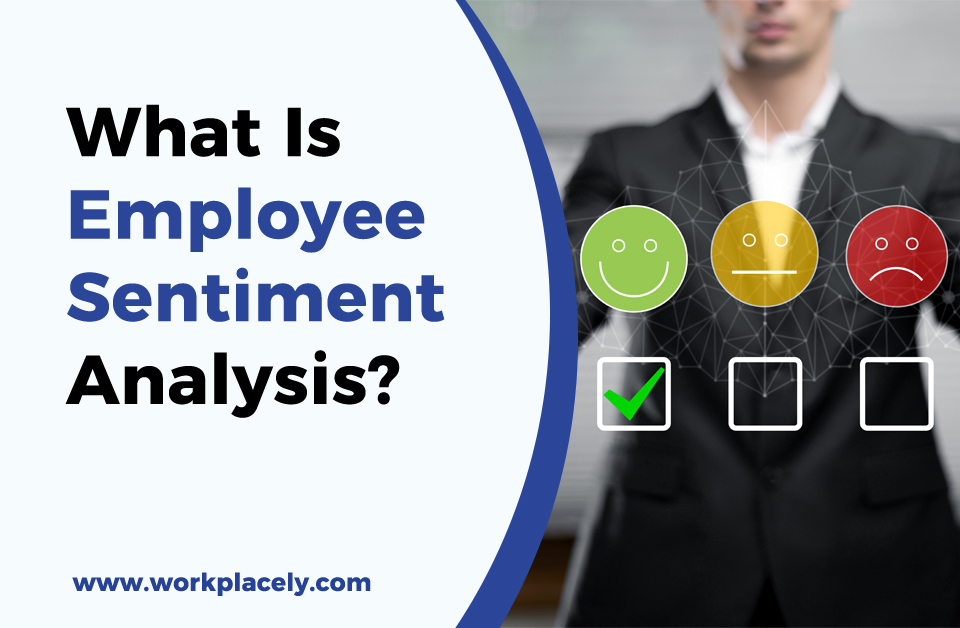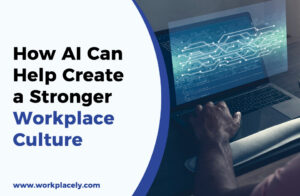Employee sentiment is the heartbeat of any thriving organization. In today’s dynamic work landscape, understanding and harnessing employee sentiment is not just a strategic advantage; it’s a necessity. Workplacely, a pioneer in employee engagement SaaS and machine learning for HR, is at the forefront of this transformative journey, where technology meets human insights to create happier, more productive workforces.
In this insightful post, we will look at the significance of employee sentiment in the modern workplace and how Workplacely’s innovative approach, combining employee engagement SaaS and machine learning for HR, reshapes how organizations understand and leverage employee emotions.
Deciphering Employee Sentiment
Employee sentiment goes beyond the surface level of job satisfaction. It’s about understanding the intricate web of emotions, concerns, motivations, and aspirations that shape an employee’s organizational experience. At Workplacely, we recognize that traditional approaches to employee feedback often provide only a fraction of the information needed for effective decision-making.
Our innovative employee sentiment analysis employs advanced techniques to delve beneath the surface. We’re not just interested in whether feedback is positive, neutral, or negative; we want to understand what drives these sentiments. This nuanced approach allows us to uncover the full spectrum of employee emotions, giving organizations the insights they need to create a workplace where employees feel heard and valued.
The Power of Understanding Employee Emotions
Emotions are the driving force behind every action and decision an employee makes. By deciphering these emotions, organizations gain a competitive edge in several crucial areas, including the following.
- Retention
Understanding what makes employees tick enables organizations to implement targeted strategies for retention. Are employees motivated by career growth? Do they seek better work-life balance? Employee sentiment analysis provides the answers.
Organizations gain insight into what motivates and engages their workforce by exploring the intricate tapestry of employee sentiment. This deeper understanding allows them to implement targeted strategies that align with individual aspirations and desires. When employees feel their emotional needs are acknowledged and valued, they are more likely to stay committed to the organization’s mission and goals.
- Engagement
Engaged employees are more productive and innovative. Employee sentiment analysis identifies the factors that boost engagement, allowing organizations to tailor initiatives accordingly.
When employees feel emotionally connected to their work, colleagues, and the organization’s overall mission, they are more likely to be dedicated and enthusiastic about their roles. This emotional bond ignites a sense of purpose, increasing creativity, innovation, and overall job satisfaction. Organizations that prioritize understanding employee emotions create an environment where engagement thrives naturally.
- Conflict Resolution
Employee sentiment analysis can uncover brewing conflicts or dissatisfaction within teams. Identifying these issues early allows for proactive resolution, preventing them from escalating into more significant problems.
Emotions are often at the heart of conflicts, and recognizing and empathizing with these emotions can lead to more productive conflict resolution. When organizations acknowledge the feelings and concerns of their employees, they create an atmosphere of trust and openness. It, in turn, encourages employees to communicate openly about their issues, facilitating smoother conflict-resolution processes.
- Personalized Support
Every employee is unique. Employee sentiment analysis helps organizations provide personalized guidance and support, addressing individual needs and concerns.
Whether it’s offering mentorship, training, or flexible work arrangements, organizations that take the time to understand employee emotions can provide growth paths aligned with their employees’ unique goals. This personalized approach enhances employee skills and strengthens their emotional connection to the organization.
The Role of Machine Learning in HR
Workplacely’s commitment to unlocking machine learning’s potential ushers in a future where employees flourish and organizations prosper. Our machine learning algorithms are designed to process vast amounts of data efficiently and identify patterns, trends, and correlations that might be invisible to conventional analysis methods.
These algorithms continuously improve, learning from historical data and real-time inputs. It ensures that the solutions we recommend are always up-to-date and in tune with the evolving needs of your workforce. In essence, machine learning for HR is a game-changer, allowing organizations to make data-informed decisions swiftly.
Employee Sentiment Analysis in Action
Let’s take a closer look at how Workplacely’s employee sentiment analysis works.
- Data Collection
At the heart of our approach is the comprehensive collection of qualitative employee feedback from diverse sources. We recognize that the spectrum of employee sentiments extends beyond the confines of formal surveys alone.
In addition to traditional surveys, we tap into the richness of employee sentiments through reviews, interactions on social platforms, and other communication channels. This multifaceted approach ensures we capture a holistic range of emotions, opinions, and perspectives.
Surveys provide structured insights into various aspects of the employee experience. These structured questionnaires allow us to dig deep into specific areas of interest, gathering targeted feedback that sheds light on the workplace’s positive and negative aspects. However, we also acknowledge that not all sentiments can be easily categorized into predefined survey questions.
Employee reviews and interactions in the digital realm provide a different dimension of insights. These unfiltered expressions offer glimpses into candid emotions, providing context and nuances that might not emerge through traditional surveys. By mining reviews and analyzing online interactions, we gain an accurate view of employee sentiments that complement the structured insights from surveys.
By casting a wide net across these diverse channels, we ensure that our data collection process reflects the complexity of human emotions and opinions. The result is a comprehensive dataset that is the foundation for our innovative employee sentiment analysis, enabling organizations to make informed decisions that resonate deeply with their workforce.
- Data Processing
Our journey into understanding employee sentiment involves a crucial step – data processing. At this stage, our advanced machine-learning algorithms come to life. They meticulously dissect the raw data, extracting essential elements like sentiment, emotion, topics, and themes.
As each piece of feedback enters our system, our algorithms get to work. They don’t just stop at labeling feedback as positive, neutral, or negative. Instead, they dive deeper, capturing a wide range of emotions – from enthusiasm and contentment to frustration and concern.
But our analysis isn’t limited to emotions alone. Our algorithms also identify recurring topics and themes that emerge from the feedback. It means they recognize the essential subjects and ideas necessary to employees.
We comprehensively view employee sentiments by combining sentiment, emotion, topics, and themes. This multi-dimensional perspective gives organizations insights into the overall tone of employee feedback and the specific areas and reasons behind certain emotions. This understanding becomes the foundation for strategic decisions that help create a workplace culture aligned with employee needs and aspirations.
- Insights Generation
The real magic happens here. We generate actionable insights from this data, highlighting areas that require attention and suggesting strategies for improvement.
As our machine learning algorithms process the vast amount of employee feedback data, they work tirelessly to uncover the valuable nuggets hidden within. The goal is to summarize sentiments and go several steps further.
Our algorithms excel at identifying specific areas that require attention within your organization. They pinpoint trends, patterns, and recurring themes within the feedback. For instance, if there’s a surge in positive sentiment about a recent change in workplace policies, our system will catch it. Conversely, if a specific department consistently shows signs of disengagement, it will stay on top of our scrutiny.
But we continue beyond merely pointing out the issues. We take it a step further by suggesting strategies for improvement. These are not generic, one-size-fits-all recommendations. Instead, they are tailored to address your organization’s precise pain points and challenges.
The insights we generate empower you to make decisions that result in positive changes. Whether enhancing employee engagement, addressing workplace concerns, or fostering a culture of continuous improvement, our insights pave the way for a more harmonious and productive work environment.
- Feedback Loop
The concept of a feedback loop is central to the effectiveness of our employee sentiment analysis. It’s not just about providing insights and leaving it at that; it’s about fostering a culture of continuous improvement within your organization.
Once our machine learning algorithms have helped uncover critical insights and your organization takes action based on these findings, the process doesn’t stop. It’s just the beginning of an ongoing cycle.
Our algorithms continue to monitor and learn as your organization implements strategies and changes based on the insights. They are finely tuned to the outcomes of the decisions made. It means that if a specific initiative successfully improves employee engagement in SaaS, our system notes it. On the other hand, if there are unexpected consequences or areas where improvements aren’t as anticipated, our algorithms capture that as well.
This continuous learning and adaptation ensure that the solutions remain effective over time. It’s a dynamic and evolving process, much like your organization itself.
In essence, the feedback loop is what turns insights into actionable results. It’s the driving force behind creating a workplace where employees feel heard, valued, and part of a thriving, ever-improving environment.
The Power of Machine Learning in Decision-Making: Workplacely’s Cutting-Edge Approach
The fusion of technology and human insights is a transformative force in modern decision-making. At Workplacely, this fusion takes shape in cutting-edge machine learning, revolutionizing how organizations decipher complex qualitative feedback and make informed choices. Here is a look into Workplacely’s innovative approach and the power of machine learning for HR to unravel intricate employee sentiments, forge logical connections, and establish trust through rigorous research.
- Holistic Analysis of Qualitative Feedback
Our custom BERT model lies at the core of Workplacely’s prowess in expedited decision-making. It is the linchpin of our innovative approach, setting us apart from off-the-shelf natural language processing solutions. While traditional models excel in dissecting individual feedback dimensions, such as sentiment or emotion, they often need to catch up on the holistic context.
Consider this: Multiple natural language processing (NLP) solutions are available today, offering high-level analysis of elements like sentiment, topic, emotion, or thematic content. However, they are typically designed only partially to analyze multiple dimensions of qualitative feedback concurrently.
Our custom BERT model bridges this critical gap by simultaneously encompassing Sentiment, Emotion, Topic, and Thematic content. This approach unveils a more complete and nuanced understanding of employee sentiments and opinions, providing organizations with a holistic view of their workforce’s feedback landscape.
- Establishing Interconnected Insights
One of our custom model’s remarkable features is its ability to forge logical connections between distinct categories within employee feedback. It transcends the boundaries of conventional analysis by empowering organizations to decipher the intricate relationships between various dimensions. For instance:
Feedback brimming with positive sentiment is likely to contain emotions like love or gratitude, as opposed to disapproval or anger.
This profound level of analysis empowers organizations to make decisions that transcend mere data-driven choices. Instead, they become nuanced, context-aware decisions—particularly vital in employee-centric contexts where emotions play a pivotal role.
- Emphasizing Validity and Reliability
Fostering trust in any decision-making system, especially one driven by machine learning, is paramount. Workplacely’s custom BERT model instills this trust through a rigorous and meticulous training process, as elucidated in our research.
Our research journey involved the human coding of over 1,800 responses, a painstaking endeavor that allows the model to detect subtle nuances in feedback with exceptional effectiveness. This rigorous approach ensures that the insights derived from the model are valid and reliable.
The metrics for evaluating the model’s performance, such as the F1 score, are industry-standard benchmarks that further guarantee its reliability. Impressively, our custom BERT model consistently achieves F1 scores exceeding 85% for sentiment and emotion identification in both test and validation sets. These scores comfortably surpass the widely accepted minimum threshold of 75% for deployment.
This research underscores the unwavering commitment of Workplacely to providing cutting-edge, accurate, and dependable solutions that empower organizations to make decisions based on the deep analysis of qualitative feedback. It’s not just about harnessing the power of machine learning; it’s about utilizing it to elevate decision-making to new heights.
Employee Sentiment Analysis: The Workplacely Advantage
Incorporating employee sentiment analysis into your organization’s strategy is not just a trend; it’s necessary in today’s competitive landscape. Workplacely empowers organizations to foster a culture of continuous improvement by understanding and addressing employee sentiment.
As we refine and expand our machine-learning capabilities, we invite organizations to join us on this transformative journey. Together, we can end Quiet Quitting, low engagement, and negative employee reviews, ushering in an era of workplace excellence driven by data, insights, and a profound understanding of employee sentiment.




